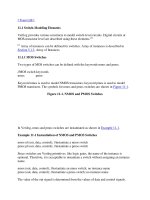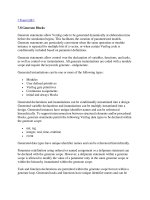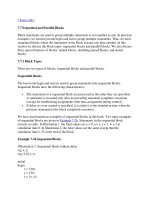Behaviotal Modeling part 3
Bạn đang xem bản rút gọn của tài liệu. Xem và tải ngay bản đầy đủ của tài liệu tại đây (22.53 KB, 7 trang )
[ Team LiB ]
7.3 Timing Controls
Various behavioral timing control constructs are available in Verilog. In Verilog, if there
are no timing control statements, the simulation time does not advance. Timing controls
provide a way to specify the simulation time at which procedural statements will execute.
There are three methods of timing control: delay-based timing control, event-based
timing control, and level-sensitive timing control.
7.3.1 Delay-Based Timing Control
Delay-
based timing control in an expression specifies the time duration between when the
statement is encountered and when it is executed. We used delay-based timing control
statements when writing few modules in the preceding chapters but did not explain them
in detail. In this section, we will discuss delay-based timing control statements. Delays
are specified by the symbol #. Syntax for the delay-based timing control statement is
shown below.
delay3 ::= # delay_value | # ( delay_value [ , delay_value [ ,
delay_value ] ] )
delay2 ::= # delay_value | # ( delay_value [ , delay_value ] )
delay_value ::=
unsigned_number
| parameter_identifier
| specparam_identifier
| mintypmax_expression
Delay-based timing control can be specified by a number, identifier, or a
mintypmax_expression. There are three types of delay control for procedural
assignments: regular delay control, intra-assignment delay control, and zero delay
control.
Regular delay control
Regular delay control is used when a non-zero delay is specified to the left of a
procedural assignment. Usage of regular delay control is shown in Example 7-10
.
Example 7-10 Regular Delay Control
//define parameters
parameter latency = 20;
parameter delta = 2;
//define register variables
reg x, y, z, p, q;
initial
begin
x = 0; // no delay control
#10 y = 1; // delay control with a number. Delay execution of
// y = 1 by 10 units
#latency z = 0; // Delay control with identifier. Delay of 20 units
#(latency + delta) p = 1; // Delay control with expression
#y x = x + 1; // Delay control with identifier. Take value of y.
#(4:5:6) q = 0; // Minimum, typical and maximum delay values.
//Discussed in gate-level modeling chapter.
end
In Example 7-10
, the execution of a procedural assignment is delayed by the number
specified by the delay control. For begin-end groups, delay is always relative to time
when the statement is encountered. Thus, y =1 is executed 10 units after it is encountered
in the activity flow.
Intra-assignment delay control
Instead of specifying delay control to the left of the assignment, it is possible to assign a
delay to the right of the assignment operator. Such delay specification alters the flow of
activity in a different manner. Example 7-11
shows the contrast between intra-assignment
delays and regular delays.
Example 7-11 Intra-assignment Delays
//define register variables
reg x, y, z;
//intra assignment delays
initial
begin
x = 0; z = 0;
y = #5 x + z; //Take value of x and z at the time=0, evaluate
//x + z and then wait 5 time units to assign value
//to y.
end
//Equivalent method with temporary variables and regular delay control
initial
begin
x = 0; z = 0;
temp_xz = x + z;
#5 y = temp_xz; //Take value of x + z at the current time and
//store it in a temporary variable. Even though x and z
//might change between 0 and 5,
//the value assigned to y at time 5 is unaffected.
end
Note the difference between intra-assignment delays and regular delays. Regular delays
defer the execution of the entire assignment. Intra-assignment delays compute the right-
hand-side expression at the current time and defer the assignment of the computed value
to the left-hand-side variable. Intra-assignment delays are like using regular delays with a
temporary variable to store the current value of a right-hand-side expression.
Zero delay control
Procedural statements in different always-initial blocks may be evaluated at the same
simulation time. The order of execution of these statements in different always-initial
blocks is nondeterministic. Zero delay control is a method to ensure that a statement is
executed last, after all other statements in that simulation time are executed. This is used
to eliminate race conditions. However, if there are multiple zero delay statements, the
order between them is nondeterministic. Example 7-12
illustrates zero delay control.
Example 7-12 Zero Delay Control
initial
begin
x = 0;
y = 0;
end
initial
begin
#0 x = 1; //zero delay control
#0 y = 1;
end
In Example 7-12
, four statements—x = 0, y = 0, x = 1, y = 1—are to be executed at
simulation time 0. However, since x = 1 and y = 1 have #0, they will be executed last.
Thus, at the end of time 0, x will have value 1 and y will have value 1. The order in
which x = 1 and y = 1 are executed is not deterministic.
The above example was used as an illustration. However, using #0 is not a recommended
practice.
7.3.2 Event-Based Timing Control
An event is the change in the value on a register or a net. Events can be utilized to trigger
execution of a statement or a block of statements. There are four types of event-based
timing control: regular event control, named event control, event OR control, and level-
sensitive timing control.
Regular event control
The @ symbol is used to specify an event control. Statements can be executed on
changes in signal value or at a positive or negative transition of the signal value. The
keyword posedge is used for a positive transition, as shown in Example 7-13
.
Example 7-13 Regular Event Control
@(clock) q = d; //q = d is executed whenever signal clock changes value
@(posedge clock) q = d; //q = d is executed whenever signal clock does
//a positive transition ( 0 to 1,x or z,
// x to 1, z to 1 )
@(negedge clock) q = d; //q = d is executed whenever signal clock does
//a negative transition ( 1 to 0,x or z,
//x to 0, z to 0)
q = @(posedge clock) d; //d is evaluated immediately and assigned
//to q at the positive edge of clock
Named event control
Verilog provides the capability to declare an event and then trigger and recognize the
occurrence of that event (see Example 7-14
). The event does not hold any data. A named
event is declared by the keyword event. An event is triggered by the symbol ->. The
triggering of the event is recognized by the symbol @.
Example 7-14 Named Event Control
//This is an example of a data buffer storing data after the
//last packet of data has arrived.
event received_data; //Define an event called received_data
always @(posedge clock) //check at each positive clock edge
begin
if(last_data_packet) //If this is the last data packet
->received_data; //trigger the event received_data
end
always @(received_data) //Await triggering of event received_data
//When event is triggered, store all four
//packets of received data in data buffer
//use concatenation operator { }
data_buf = {data_pkt[0], data_pkt[1], data_pkt[2], data_pkt[3]};
Event OR Control
Sometimes a transition on any one of multiple signals or events can trigger the execution
of a statement or a block of statements. This is expressed as an OR of events or signals.
The list of events or signals expressed as an OR is also known as a sensitivity list. The
keyword or is used to specify multiple triggers, as shown in Example 7-15
.
Example 7-15 Event OR Control (Sensitivity List)
//A level-sensitive latch with asynchronous reset
always @( reset or clock or d)
//Wait for reset or clock or d to change
begin
if (reset) //if reset signal is high, set q to 0.
q = 1'b0;
else if(clock) //if clock is high, latch input
q = d;
end
Sensitivity lists can also be specified using the "," (comma) operator instead of the or
operator. Example 7-16
shows how the above example can be rewritten using the comma
operator. Comma operators can also be applied to sensitivity lists that have edge-sensitive
triggers.
Example 7-16 Sensitivity List with Comma Operator
//A level-sensitive latch with asynchronous reset
always @( reset, clock, d)
//Wait for reset or clock or d to change









